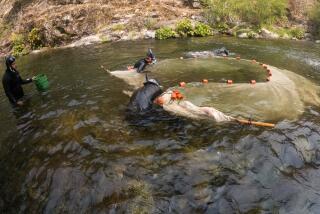Selenium Cut Drastically in Kesterson Tests
- Share via
Toxic levels of selenium that killed and deformed waterfowl and wildlife at the Kesterson National Wildlife Refuge in Merced County have dropped dramatically during the last year in four experimental ponds, a team of California scientists reported Tuesday.
The findings suggest that there may be an economical way to clean up Kesterson, as well as other wildlife refuges across the country that are also threatened by selenium, the U.S. Bureau of Reclamation said.
Scientists at Lawrence Berkeley Laboratory, in a report to the bureau, said that selenium levels in water plunged to an average of 5 parts per billion from more than 400 ppb simply by flooding the contaminated ponds with selenium-free groundwater. The goal is 2 ppb.
Of greater importance, they said, was that as selenium levels plummeted in the ponds, they also dropped significantly in most of the primary food chain, which includes vegetation and organisms living in the ponds’ selenium-laden mud.
In the food chain, current levels are 50 parts per million. If the declines continue, Lawrence scientist Sally Benson said in an interview, the levels could reach acceptable levels within the next few years.
Selenium is a natural mineral found in the soil. In minute amounts, it is necessary for human and animal nutrition. But it is toxic in high concentrations. Selenium levels skyrocketed at Kesterson because its ponds became the catch basins for agricultural waste water laden with selenium from ranches in the western San Joaquin Valley. The state Water Quality Control Board ordered the bureau to stop accepting the waste water as of June, 1986.
Since then, the bureau has been casting about for the best way to comply with a state board order to clean up the wildlife refuge by next August.
The Bureau of Reclamation has long argued that by flooding the ponds with selenium-free water, levels of the naturally occurring element would not only be reduced but also be chemically immobilized so that selenium could not easily enter the food chain.
The state Water Quality Control Board said Tuesday that it never doubted that selenium levels in the water itself would drop and added that it was not surprised by the findings.
‘Long-Term Mobility’
But the board cautioned that it has always been concerned that the selenium previously deposited in the ponds would be taken up by vegetation and organisms and enter the food chain. State officials also said they were concerned that the selenium in the bottom sediments would leach into the underground water aquifers.
Tom Howard, a staff engineer with the state board who supervised the state’s evaluation, told The Times, “The question the board was dealing with was the long-term mobility of the selenium into vegetation and groundwater.”
The state rejected the bureau’s so-called “wet-flex” approach, saying that the bureau lacked convincing scientific evidence that it would work. Instead the state ordered the bureau to drain the ponds, scrape up the bottom muds and sediment and bury them in a landfill at the site at a cost 10 times greater than the $2.4-million flooding plan.
On Tuesday, however, the Bureau of Reclamation and Benson said the new facts collected during the past year “clearly demonstrate” the efficacy of the wet-flex plan.
“I think we have a lot more data on mud and root uptake from Kesterson,” Benson said. “Rooted cattails demonstrated large declines, as well as everything else. It appears that even the organisms living in the muds are clearing up at a somewhat slower but a significant rate,” she said.
She said data from a pond that dried up and was later reflooded with groundwater “showed that selenium wouldn’t be flushed into groundwater . . . .”
More to Read
Sign up for Essential California
The most important California stories and recommendations in your inbox every morning.
You may occasionally receive promotional content from the Los Angeles Times.













